When you buy through our links, we may earn an affiliate commission.
Imagine having your own home theater to enjoy hot new movies, video games, and music videos to the absolute fullest. An AV Receiver will be at the heart of this system, connecting your surround sound audio and high-definition video into one synchronized package.
The right AV Receiver will make all this possible so that having the best home theater out of everyone you know will no longer be just in your imagination.
You do have to make sure your AV Receiver has the specifications to actually be compatible with all the other gear that goes into your home theater. It can be tricky to get everything perfect.
But don't worry; we've put together a list of five fantastic AV Receivers, as well as a buyer's guide so you can find the ideal one for you. Our number one spot goes to the Denon AVR-S660H because it has the specifications that allow for a top-of-the-line theater system, all in a sleek and affordable package.
So once you've got your flat-screen TV, surround sound speakers, and engaging movie to watch, pick up one of these AV receivers to bring the vision to life!
Quick Summary of the Best AV Receivers
- Denon AVR-S660H (Best Overall)
- Sony STR-DN1080 (The Runner-Up)
- Arcam AVR31 (Best High-End Choice)
- Yamaha AVENTAGE RX-A8A (Best Interface)
- Yamaha 5.1-Ch. 4K Ultra HD A/V Home Theater Receiver (Best Budget Choice)
Best AV Receivers
1. Best Overall – Denon AVR-S660H
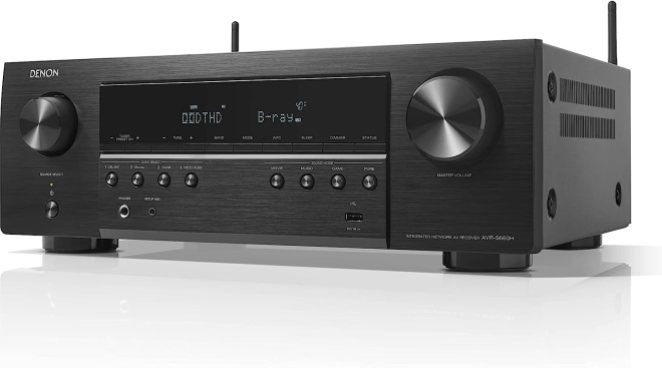
SPECS
- Price: $499
- 5.2 Surround Sound Channels
- 8K Ultra HD
- 6 HDMI Inputs
- 75 Watts per Channel
Whether you're an avid music listener, a film aficionado, or a gaming fanatic, you will be blown away by the Denon AVR-S660H. This product was designed to meet all your audio and video needs.
When it comes to AV Receivers, there is no one size fits all. What matters is that you find one that supports all of the specific audio/video formats you plan to use and has the correct compatibility with your other cables and devices.
The Denon AVR-S660H gets the number one spot because it supports all the most commonly used video and audio formats and has enough power to keep up with just about any speaker, TV, or projector you connect it to.
This product has more than enough features to fit in with most people's home theater systems and at a lower price tag than similar AV Receivers. Three 8K inputs support the latest HDMI specifications - 8K/60Hz, select 4K/120Hz pass-through, VRR, Dolby Vision™, HDR10+, and ALLM.
With five channels and 75 Watts per channel, you can achieve fully immersive surround sound.
The Denon also has compatibility with all sorts of apps and virtual assistants, such as Spotify, Alexa, Siri, and the Denon AVR Remote Control App. Fine-tuning the specifications of your audio and video is a breeze with the Audessey MultEQ app.
For most people, the Denon AVR-S660H is the only AV Receiver you will ever need. You can connect it to multiple different speakers in different rooms and conveniently control each one remotely. Sync up all the speakers to play the same song, or alternatively, you can play a different song in each room.
Denon is an extremely well-established brand in the AV Receiver and audio interface space thanks to its excellent build and sound quality. The features and specifications of their products are clearly laid out in a digestible way, and their customer service tends to be dependable.
This is one of Denon's more affordable products, and it still packs in an impressive number of features. You can check out other similar products in the Denon lineup if you're looking for specifications that this one does not have, such as 7.2 Surround Sound.
2. The Runner-Up – Sony STR-DN1080
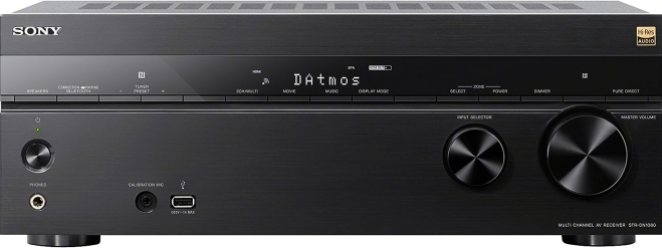
SPECS
- Price: $489
- 7.2 Surround Sound Channels
- 4K Ultra HD
- 6 HDMI Inputs
- 100 Watts per Channel
There is a lot to love about the Sony STR-DN1080. When it comes to audio devices, Sony is one of the most respected brands, having built up a solid reputation for decades.
Compatible with Chromecast, AirPlay, Multi-Room, and Google Home, this device offers cinematic sound at home, with seven channels of surround sound. Your home theater system will be able to stream music and watch movies with top-notch audio performance.
Digital Cinema Auto Calibration makes adjustments to your existing speaker system to closely simulate the sound of optimally positioned speakers.
It is capable of decoding surround sound codecs and playing them on a system with only two or more speakers. This means you can create surround sound even if you don't have a full five or seven speaker system.
It also supports high-resolution audio that beats CD quality.
The Sony STR-DN1080 falls short of the Denon AVR-S660H in just a couple of specifications - most notably, the video quality. The Sony only supports 4K HDR rather than 8K HDR.
For some people, this won't actually matter (if you plan to use the AV Receiver with a TV that doesn't support 8K video, for instance).
Still, with Chromecast built-in, you'll be able to access all your favorite SmartHome apps. There are many appealing features and capabilities of this AV Receiver, so if you have no need for 8K video, then this may have all the features you will ever need.
3. Best High-End Choice – Arcam AVR31
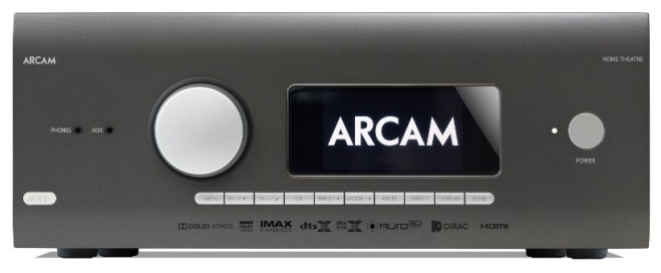
SPECS
- Price: $5,520
- 15.2 Surround Sound Channels
- 8K Ultra HD
- 7 HDMI Inputs, 3 HDMI Outputs
- 100 - 180 Watts per Channel
The Arcam AVR31 is exceptional in every way. It has enough inputs and internal specifications to support the highest-quality video and audio files available today.
Arcam's Class G audio amplification can handle any audio codecs and will efficiently deliver clean audio that is free of distortion, even in the low end. It natively supports up to seven channels of Class G audio amplification and has the ability to decode up to 15.1 channels if you hook up external amplification.
Its surround sound decoders include Dolby Digital, Dolby Atmos, DTS decoder, and DTS:X. Essentially, this device is prepared to handle just about any surround sound system you throw at it.
With between 100 and 180 watts per channel, the Arcam can handle up to 1260 watts in total. This is an insane amount of power that is more than enough for most home theaters.
As for the design, the Arcam AVR31 is simple, modern, and stylish. The screen on the front displays information beautifully, and all the buttons are laid out conveniently underneath the display. We particularly like the simple power button and large volume knob.
For a product this pricey, we would recommend talking to an expert or doing your own research to make sure it has all the specifications you're after and that you can't find something else that can do it all for cheaper.
4. Best Interface – Yamaha AVENTAGE RX-A8A
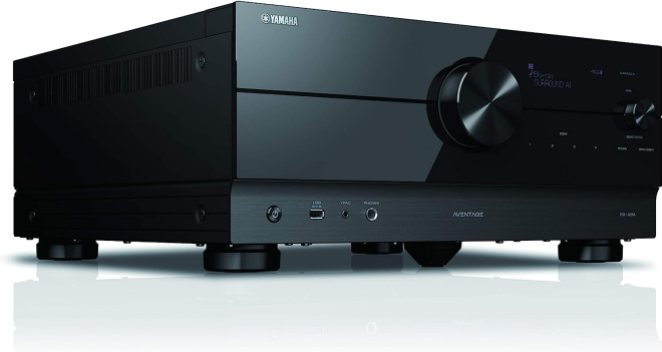
SPECS
- Price: $2,999
- 11.2 Surround Sound Channels
- 8K Ultra HD
- 7 HDMI Inputs
- 150 Watts per Channel
Yamaha's reputation for dependable, budget-friendly musical instruments does not entirely transfer over to its offerings in consumer electronics. Yamaha is not quite as well known for its speakers, pre-amps, or other more technical devices.
In the case of the Yamaha AVENTAGE RX-A8A, however, Yamaha delivers a product capable of going toe to toe with the likes of Sony, Denon, and any other brand. The AVENTAGE RX-A8A is a fantastic AV Receiver!
Something that immediately sets this AV Receiver apart from its competitors is the visual design approach. The sleek, modern, minimalist design will look great anywhere you put it.
We love the large, center-justified control knob along with the understated display elements on the right side of the console.
11.2 channel surround sound with 150 Watts per input makes this device capable of handling top-of-the-line surround sound to make all your most epic movies sound even more epic. AI technology is built into the device to effortlessly optimize your surround sound for you.
Yamaha is exceptionally good at fitting lots of features into their products while still maintaining a high level of user-friendliness. They prioritize intuitive design choices, making sure their product is as easy to use as possible, even while being very feature-rich.
You'll also get a three-year manufacturer warranty from Yamaha, as well as a high likelihood of great customer service.
5. Best Budget Choice – Yamaha 5.1-Ch. 4K Ultra HD A/V Home Theater Receiver
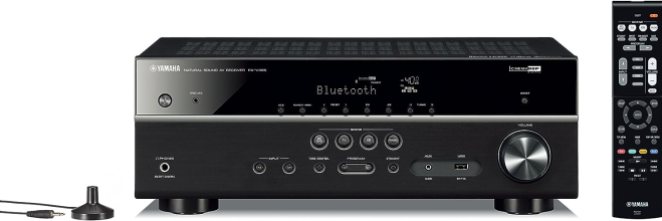
SPECS
- Price: $349
- 5.1 Surround Sound Channels
- 4K Ultra HD
- 5 HDMI Ports
- 100 Watts per Channel
Yamaha strikes again with a solid budget-friendly product for people who want to buy from a trusted brand without breaking the bank.
The Yamaha 5.1-Ch. 4K Ultra HD A/V Home Theater Receiver lacks many of the features of the other contenders, most notably in its connectivity options, but it also comes at a fraction of the price.
And since it's Yamaha, you know it is made of high-quality, long-lasting materials.
With four HDMI inputs and 145-watt RMS power, this AV Receiver can power speakers in your living room with ease. Unlike pricier receivers, however, it lacks support for multi-room wireless audio.
But fear not. The Yamaha Home Theater Receiver has four HDMI inputs, a USB input, Bluetooth connectivity, Composite Video Inputs, and Analog Audio Inputs. It is equipped to handle a home theater with 5.1 surround sound audio.
While it lacks support for high-resolution audio, it does offer room correction/room calibration. You can enjoy great sound from your movies or streaming services. The standard budget-savvy consumer who just wants a home theater setup will be more than satisfied with this receiver.
Best AV Receivers Buyer's Guide
AV Receivers don't get a lot of attention compared to other electronics because their only job is to support other devices. For this reason, it can be hard to know exactly what to look for when searching for the best AV Receiver for you.
This buyer's guide will tell you the most important aspects of AV Receivers to consider when searching for one to purchase.
Supported Audio and Video Formats
Do some research as to the type of audio and video formats that are supported by your TV, projector, or speaker system. The best AV Receiver for you will support all those formats.
For example, make sure your receiver supports the type of surround speakers you plan to use. How many channels of surround sound audio do you need? Most people will be happy with 5.1, but some surround sound systems will warrant 7.1 or more.
Connectivity Capabilities
The best receiver for you will have all the connectivity capabilities your home theater will need. Pay attention to the number of speaker channels, the number of HDMI ports, and the number of analog inputs.
If you already have your speaker system picked out, then make sure your AV Receiver has the correct inputs and the correct amount of inputs to support all the speakers.
It is also worth noting whether your receiver is compatible with Bluetooth, airplay, or other types of connectivity. These can be useful for wireless speakers or controlling your receiver from your mobile device.
Since an AV Receiver basically serves as a connectivity hub between all your audio and video devices, it is arguable that their connectivity capabilities are their most important feature.
Speaker Calibration and Room Correction
Powerful, intelligent speaker calibration and room correction capabilities are some of the things that differentiate higher-end AV Receivers from more entry-level ones.
Good speaker calibration doesn't just result in better sound quality; it results in more transparent surround sound that sounds how it was intended to sound.
Room correction will adjust the EQ, panning, and sound profile of your audio to optimize the sound for any type of speaker setup. Typically, this can be done automatically or manually.
An excellent receiver will have excellent speaker calibration and room correction so that your audio system sounds pristine, no matter the placement of the individual speakers.
Power and Performance
Make sure your AV Receiver can handle all the Watts your speaker and video systems require.
Brand Reputation
Since AV Receivers are so central to your home theater and tend to come with a price tag that reflects that, it is a good idea to buy yours from a trusted brand. You might be able to find some super-budget receivers out there, but they will be more prone to problems, shortcomings, and depreciation.
Fortunately, all receivers on this list come from trusted brands that will give you the peace of mind you're looking for.
User Reviews
User reviews tend to be a trustworthy measure of any product's quality. The best AV receiver for you will likely have a high number of positive reviews.
Size and Weight
Many AV Receivers weigh up to 50 pounds, while others weigh around 15 pounds. It's a good idea to be aware of the size and weight of your AV Receiver so you know it will physically fit in the space you plan to put it.
Interface and User Friendliness
The best AV Receiver for you will have an interface you understand. Ease of use is important, especially with a product that can get rather complicated in its applications.
Aesthetics
If there are multiple similarly priced receivers that have all the inputs and functionalities you need, then it just comes down to aesthetics. Do you like the way your receiver looks on your shelf?
Frequently Asked Questions (FAQs)
What is an AV receiver?
An AV receiver, short for an Audio-Visual receiver, is a central component in a home theater or audio system that acts as a hub for connecting and controlling various audio and video sources. It plays a crucial role in managing and enhancing the audio and video experience in your entertainment setup.
In what circumstances will I need an AV receiver?
Let's say you plan to create a surround sound system with several speakers (one center speaker, two overhead speakers, and two bookshelf speakers). Let's also say you want to use these speakers to play the audio from your Blu-ray player.
You need a device to receive all the audio and video signals from your speakers and video player and calibrate them so they are synced up for the ideal viewer experience.
This is why AV Receivers are central to any home theater.
There are other circumstances where you may need an AV Receiver (or just a stereo receiver if there is no video component). Generally, any time multiple speakers or video devices need to be synced up, it calls for a receiver.
How do I set up my AV receiver?
The answer to this question is highly dependent on your specific theater setup. Generally, you'll want to hook up all the speakers and video players into the correct ports and plug in the receiver itself. At that point, you'll be able to use the remote to navigate to the desired mode and make calibrations.
The user manuals or startup guides tend to be available for all major AV Receivers, and you can contact a customer support rep who will be happy to help you through the process.
What is speaker calibration, and why is it important?
Speaker calibration is a function that makes minor adjustments to the audio signal so that it is optimized for your speaker setup. The placement and distance between your speakers can affect the sound, so this will ensure you get pure sound quality that sounds how it was intended.
What devices can I connect to my AV receiver?
Generally speaking, most AV Receivers allow you to connect any devices that are compatible with their inputs. If your receiver has Bluetooth, you can connect anything with Bluetooth capabilities.
If it has HDMI output or input, you can connect anything that uses an HDMI cable. The same is true for all different input types.
Conclusion
We hope you have enjoyed this overview of the best AV Receivers on the market right now.
Pick up our number one choice, the Denon AVR-S660H, and you are sure to be satisfied. Having a well-made, powerful receiver at the heart of your home theater will ensure that you have an enthralling, hassle-free experience with your favorite media.
Once you start to play music and video with ease using your receiver, it will be hard to settle for less than the customized, top-of-the-line home theater you've created! Happy viewing!
Interested for more sound systems? Take a look at the best surround sound system!
